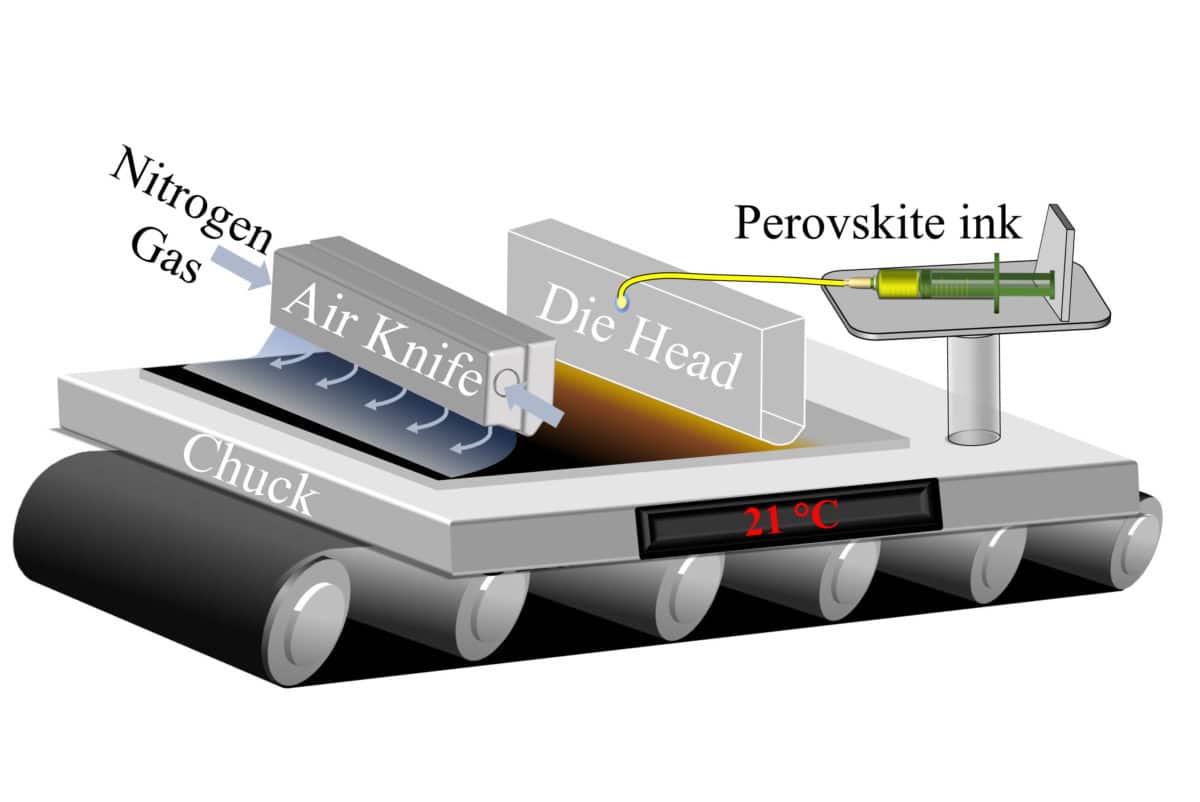Perovskite solar cells, it seems, have been on the verge of large-scale production for a couple of years now. Researchers are testing a variety of different routes to reproducing the already impressive results shown in small-scale laboratory devices in an industrial setting, which will require a move away from the spin-coating processes used in research.
Slot die coating, where an ‘ink’ flows from a rectangular slot onto a moving substrate below, is one of the most promising approaches, proven in other industries to allow low cost, reproducible production at scale. And perovskite researchers have been hard at work optimizing perovskite precursor solutions to be deposited in this way, and to maintain stability and performance over a much larger area.
Crystallization
Controlling the crystallization of the material as it is coated is key to producing efficient solar cells, and this was the focus for scientists at Germany’s Helmholtz Zentrum Berlin (HZB) working on a perovskite material suitable for slot die coating. “One of the most important aspects to optimize slot‐die coating for MHP [metal-halide perovskite] deposition is to develop reproducible coating processes where the MHP crystallization is selectively induced during the coating process,” the scientists explain.
The group found that adding a ‘coordinating solvent’ to the precursor material gave them additional control over this crystallization process, and that adding exactly the right amount improved the quality of the resulting thin film.
Popular content
The additive, dimethyl sulfoxide (DMSO), was shown to encourage the growth of perovskite crystals and improve the quality. Add to much though, and other processes begin to have a negative effect. “It's like seasoning a soup,” explains HZB scientist Eva Unger. “If you add too little, it remains bland. If you add too much, it won't taste good either. So you need to add just the right amount to make it best.”
At a concentration of 11.7 mole-percent (mol%), the group was able to produce solar cells at 20.83% efficiency (stabilized at 20.55%). The work is described in the paper 20.8% Slot‐Die Coated MAPbI3 Perovskite Solar Cells by Optimal DMSO‐Content and Age of 2‐ME Based Precursor Inks, published in Advanced Energy Materials.
The group also investigated how long their inks would last, finding that the 11.7 mol% solution could still produce 19.5% efficient cells after 18 days in storage, while higher concentrations of DMSO could not produce good quality coatings at all after this time. “This is an aspect that has received little attention so far”, Unger explains. “The age of a perovskite precursor ink can influence device performance. This is an important factor that must be considered when developing inks and processes.”
This content is protected by copyright and may not be reused. If you want to cooperate with us and would like to reuse some of our content, please contact: editors@pv-magazine.com.



1 comment
By submitting this form you agree to pv magazine using your data for the purposes of publishing your comment.
Your personal data will only be disclosed or otherwise transmitted to third parties for the purposes of spam filtering or if this is necessary for technical maintenance of the website. Any other transfer to third parties will not take place unless this is justified on the basis of applicable data protection regulations or if pv magazine is legally obliged to do so.
You may revoke this consent at any time with effect for the future, in which case your personal data will be deleted immediately. Otherwise, your data will be deleted if pv magazine has processed your request or the purpose of data storage is fulfilled.
Further information on data privacy can be found in our Data Protection Policy.